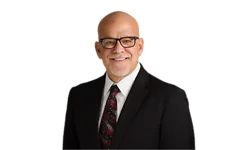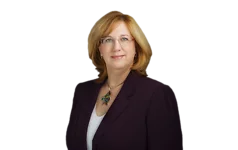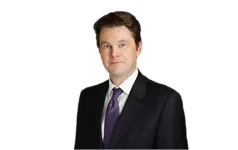U.S. Supreme Court Clarifies School District Authority to Punish Off-Campus Student Speech
Student “B.L.” was very upset. After her freshman year on the junior varsity cheerleading squad, she hoped to make the varsity squad for her sophomore year. She didn’t. Frustrated with this development, frustrated with the knowledge that an incoming freshman was selected for the varsity squad, and frustrated with school and club softball developments, she decided to share her frustration on Snapchat one weekend. Her two posts, one of which included a photo of her and a friend hoisting a middle finger, read “[F**k] school [f**k] softball [f**k] cheer [f**k] everything,” and “Love how me and [another student] get told we need a year of jv before we make varsity but that’s (sic) doesn’t matter to anyone else?”
The Snapchat story was viewed by about 250 of B.L.’s “friends,” many of whom were classmates and teammates, and not surprisingly screenshots of the posts went viral and made their way to B.L.’s high school cheerleading coaches. A brief discussion of B.L.’s posts also occurred amongst students in a math class taught by one of the coaches. As a result, the coaches removed B.L. from the cheerleading program for the remainder of the year, stating the posts violated program rules and the school’s rules for student-athlete conduct, which she and a parent had acknowledged in writing. B.L. and her parents appealed the decision to the athletic director, the principal, the district superintendent, and the school board; all of them sustained the coaches’ decision and stated B.L.’s only remedy would be to try out for cheerleading at the end of her sophomore year.
B.L., through her parents, filed a lawsuit in federal court, arguing the one-year suspension violated her First Amendment rights, the school and team rules were overbroad and constituted viewpoint discrimination, and that the rules were unconstitutionally vague. On appeal before the Third Circuit Court of Appeals, the court not only ruled in B.L.’s favor, but it broke with every other federal circuit addressing the issue and concluded public school districts have no authority to punish students for off-campus speech. More specifically, the Third Circuit concluded the standard set long ago in Tinker v. Des Moines Independent Community School District (1969) 393 U.S. 503 — that school authorities can regulate student speech where the exercise of speech “materially disrupts classwork, or involves substantial disorder or invasion of the rights of others” — does not apply to off-campus speech, and therefore cannot be a basis for school regulation or discipline of off-campus speech.
The U.S. Supreme Court agreed to review the decision, expressly to address whether school districts can discipline students for off-campus speech and, if so, to what extent. In an 8-1 decision, the Court disagreed with the Third Circuit’s holding that off-campus speech can never be regulated, but concluded nonetheless that in this case the school district violated B.L.’s First Amendment rights. The decision provides guidance, though general, regarding the standards for distinguishing a school district’s authority to regulate off-campus speech as opposed to on-campus speech.
The Supreme Court Decision
In Mahanoy Area School District v. B.L. By and Through Levy (2021) ___ U.S. ___, 2021 WL 2557069, the Supreme Court disagreed with the Third Circuit’s conclusion that Tinker does not apply to off-campus speech in any situation, noting that such “would deny the off-campus applicability of Tinker’s highly general statement about the nature of a school’s special interest.” The Court stressed that public schools have a “special characteristic” in that they “at times stand in loco parentis, i.e., in the place of parents.” As such, the Court did “not believe the special characteristics that give schools additional license to regulate student speech always disappear when a school regulates speech that takes place off campus.”
Rather than announce an over-generalized standard for determining off-campus versus on-campus speech and what First Amendment protections apply to specific scenarios, the Court listed “three features of off-campus speech that often, even if not always, distinguish schools’ efforts to regulate that speech from their efforts to regulate on-campus speech.” Under this approach, schools have less authority to regulate off-campus speech than on-campus speech.
First, a school, in relation to off-campus speech, “will rarely stand in loco parentis” as off-campus activities “normally fall within the zone of parental . . . responsibility.” Second, regulation of off-campus and on-campus speech will “include all the speech a student utters during the full 24-hour day.” Therefore, courts must exercise more restraint in determining a school’s ability to regulate off-campus speech. The Court stressed that when it comes to off-campus “political or religious speech,” a school has a heavier First Amendment burden to justify regulation. Third, the Court stated schools have a strong interest in protecting unpopular student opinions, especially when they are expressed off-campus, because “public schools are the nurseries of democracy.”
After laying out these three off-campus speech considerations, the Court left the door open for “future cases to decide where, when, and how these features mean the speaker’s off-campus location will make the critical difference.” The Court’s rationale recognized the different kinds of off-campus speech, especially in the modern world of smartphones and social media, and of the different extents to which circumstances could justify First Amendment leeway (safety, bullying, cheating, etc.).
Turning to the facts of the case before it, the Court used B.L.’s speech to provide one example of when off-campus speech should be protected by the First Amendment. The Court characterized B.L.’s speech as “criticism” that “did not involve features that would place it outside the First Amendment’s ordinary protection.” The content of B.L.’s Snapchat posts did not contain fighting words or obscenity, but rather contained “pure speech” that if uttered by an adult would receive First Amendment protection. The Court next analyzed the context in which the posts were made. Of importance was that the posts were made outside of school hours, away from the physical location of the school, did not identify the school, employees, or classmates, were made using a personal device, and spoke to a “private circle.” Although the speech had potential of reaching the school, the context in which the speech was made diminished the school’s authority, according to the Court.
In addressing the school’s interest in regulating the speech, the Court first noted that the school’s interest in “teaching good manners” and “punishing the use of vulgar language aimed at part of the school community” was considerably weak because B.L.’s speech occurred outside the school and on her own time, meaning the school did not stand in loco parentis. Second, and importantly, the Court concluded the school’s interest in preventing disruption within the school (classroom or extracurricular) was unsupported as B.L.’s posts did not cause substantial disruption under Tinker. Specifically, the school district was only able to show that B.L.’s posts resulted in a discussion of a couple of minutes during a math class, and that a few cheerleaders were upset by the comments. Finally, the Court concluded the school’s interest in preserving “team morale” was unsupported, and that mere apprehension is not enough to overcome the Tinker standard.
Impact on California Public Schools
As the Supreme Court is the ultimate court of authority in the United States, its ruling in Mahanoy effectively overrules all current Court of Appeals decisions in conflict with it. Needless to say, the Third Circuit’s determination that schools can never regulate off-campus speech is null and void, but, importantly, we do not interpret the Mahanoy decision as significantly impacting the current rule in California or the authorizations in the Education Code.
California public schools are generally held to the standard set forth by the Ninth Circuit in McNeil v. Sherwood School District 88J (9th Cir. 2019) 918 F.3d 700. There, the court was confronted with whether a school could constitutionally discipline a student for off-campus speech when the student wrote a list of students who “must die” in his personal journal. Noting that no previous Ninth Circuit decision had “settled on a test for determining when a school can constitutionally regulate off-campus speech,” the court concluded that “a school district may constitutionally regulate off-campus speech … based on the totality of the circumstances [when] the speech bears a sufficient nexus to the school.” The test is meant to be “flexible and fact-specific,” taking into consideration: (1) “the degree and likelihood of harm to the school caused or augured by the speech,” (2) “whether it was reasonably foreseeable that the speech would reach and impact the school,” and (3) “the relation between the content and context of the speech and the school.” The potential threat of violence arising from off-campus speech cannot be merely perceived, a school must reasonably believe the school faces a credible safety threat.
This test is not inconsistent with Mahanoy, and is consistent with Education Code provisions regarding suspension or expulsion, and with sections addressing student free speech rights. Section 48900(r), for example, authorizes the discipline of students who engage “in an act of bullying,” including by an “electronic act” created or transmitted “on or off the schoolsite” such as “[a] post on a social network internet website.” An act of bullying, whether committed in-person or via an electronic act, is subject to discipline if it is “directed toward one or more pupils that has or can be reasonably predicted to have the effect of:” (1) impacting the pupils’ physical or mental health, (2) substantially affecting the pupil’s academic performance, or (3) interfering substantially with the pupil’s ability to engage in benefits and services provided by the school. The same provision establishes that “an electronic act shall not constitute pervasive conduct solely on the basis that it has been transmitted on the internet or is currently posted on the internet.” Rather, a student can only face disciplinary action if “the act is related to a school activity or school attendance occurring within a school under the jurisdiction of the superintendent of the school district or principal or occurring within any other school district.”
As for statutory free speech protections, section 48907 protects California public school student’s right to exercise free speech, but it incorporates Supreme Court doctrine including the Tinker “substantial disruption” test. Similarly, section 48950 prohibits punishing students for speech that would be protected by the First Amendment off-campus, carves out exceptions for “harassment, threats, or intimidation,” explicitly states that it does not limit or modify section 48907 (which incorporates Tinker), and authorizes reasonable time, place, and manner regulations.
These provisions, along with the general jurisdictional requirement that conduct be “related to school activity or attendance” to subject a student to discipline (Ed. Code § 48900(s)), are not materially impacted by the Mahanoy decision. This is especially true when one considers, again, the facts in Mahanoy, which did not involve bullying, harassment, threats or intimidation, did not involve statements directed at specific individuals, and were, although crudely stated, criticisms directed more at decisions than individually-named people.
Emaleigh White, summer clerk in AALRR’s San Diego office, assisted in the preparation of this ALERT.
This AALRR publication is intended for informational purposes only and should not be relied upon in reaching a conclusion in a particular area of law. Applicability of the legal principles discussed may differ substantially in individual situations. Receipt of this or any other AALRR publication does not create an attorney-client relationship. The Firm is not responsible for inadvertent errors that may occur in the publishing process.
© 2021 Atkinson, Andelson, Loya, Ruud & Romo
Attorneys
 Partner858-485-9526
Partner858-485-9526 Partner949-453-4260
Partner949-453-4260 Partner562-653-3200
Partner562-653-3200 Partner562-653-3200
Partner562-653-3200
